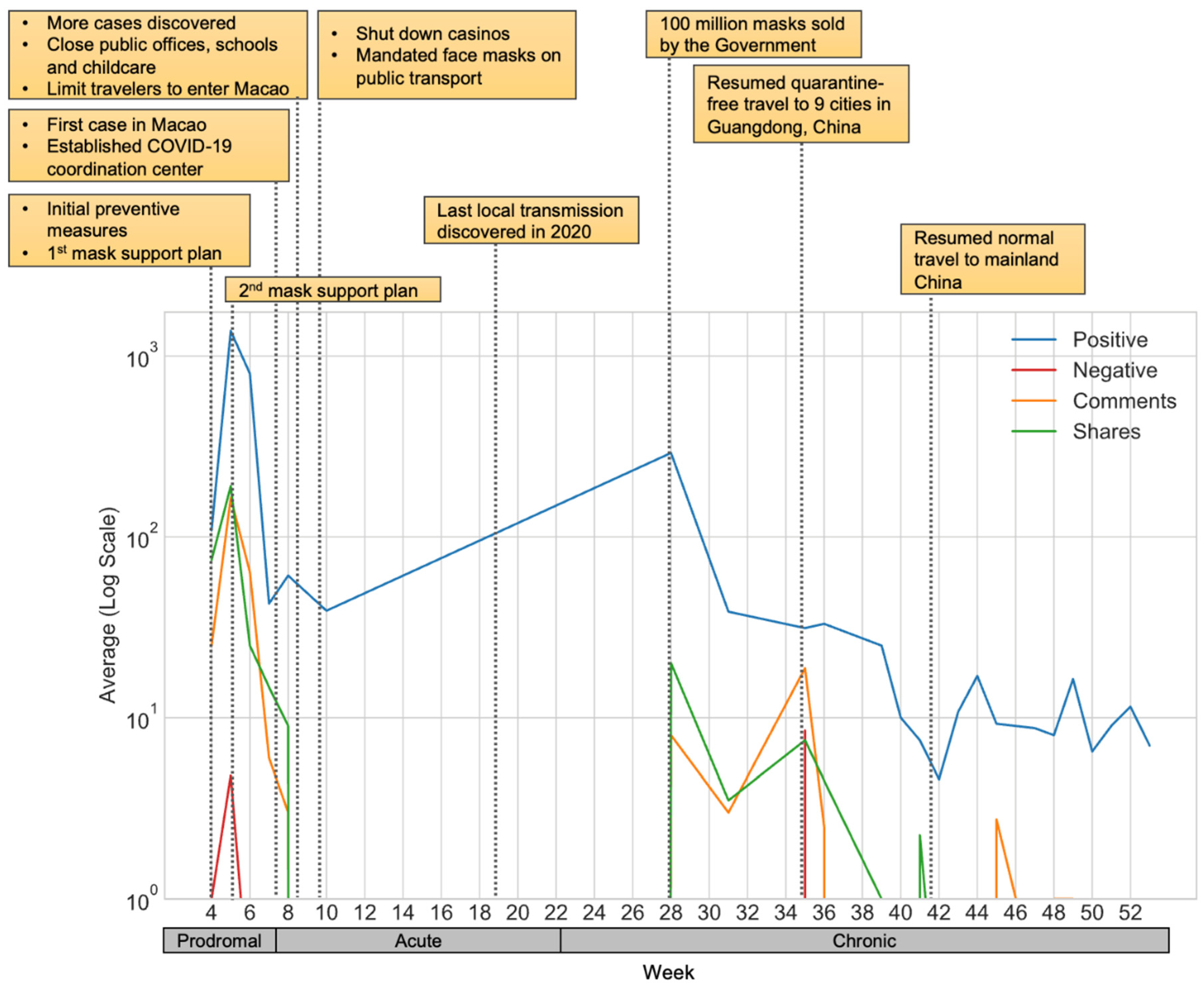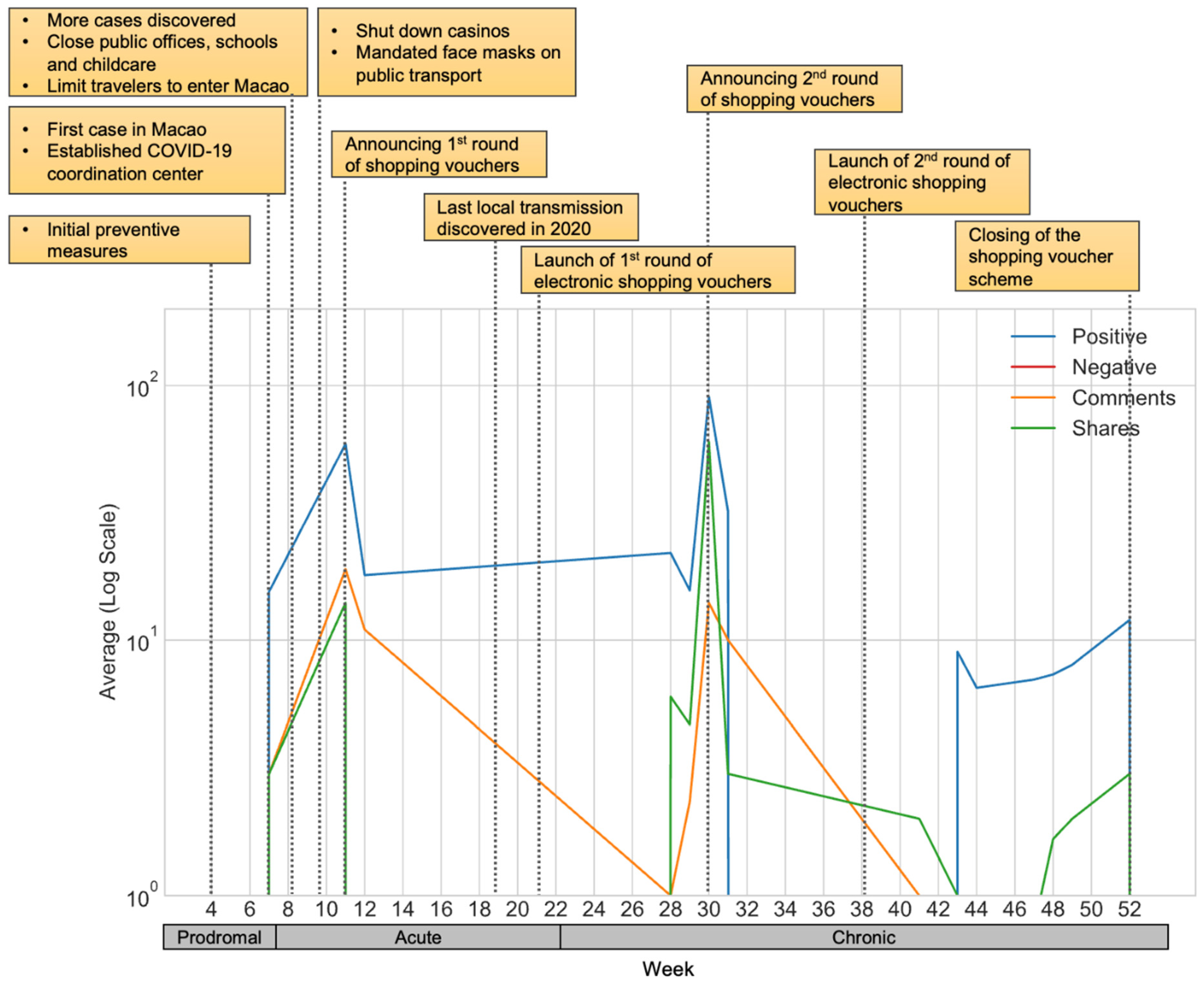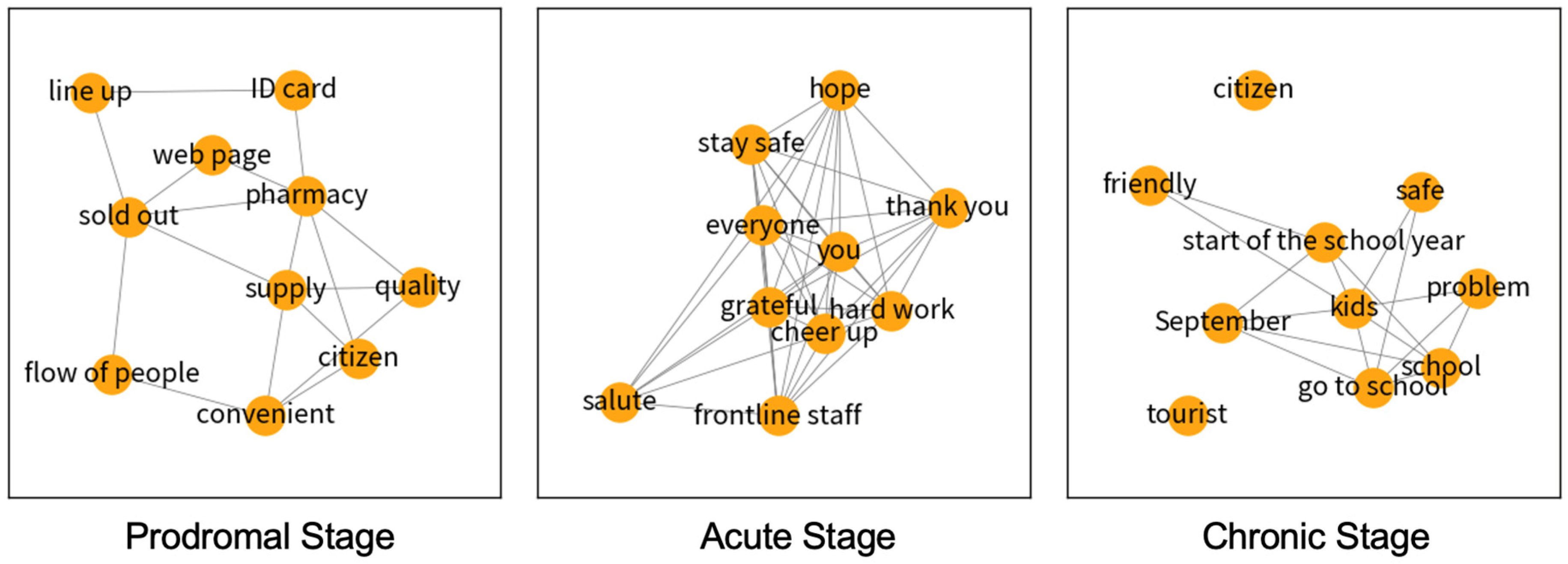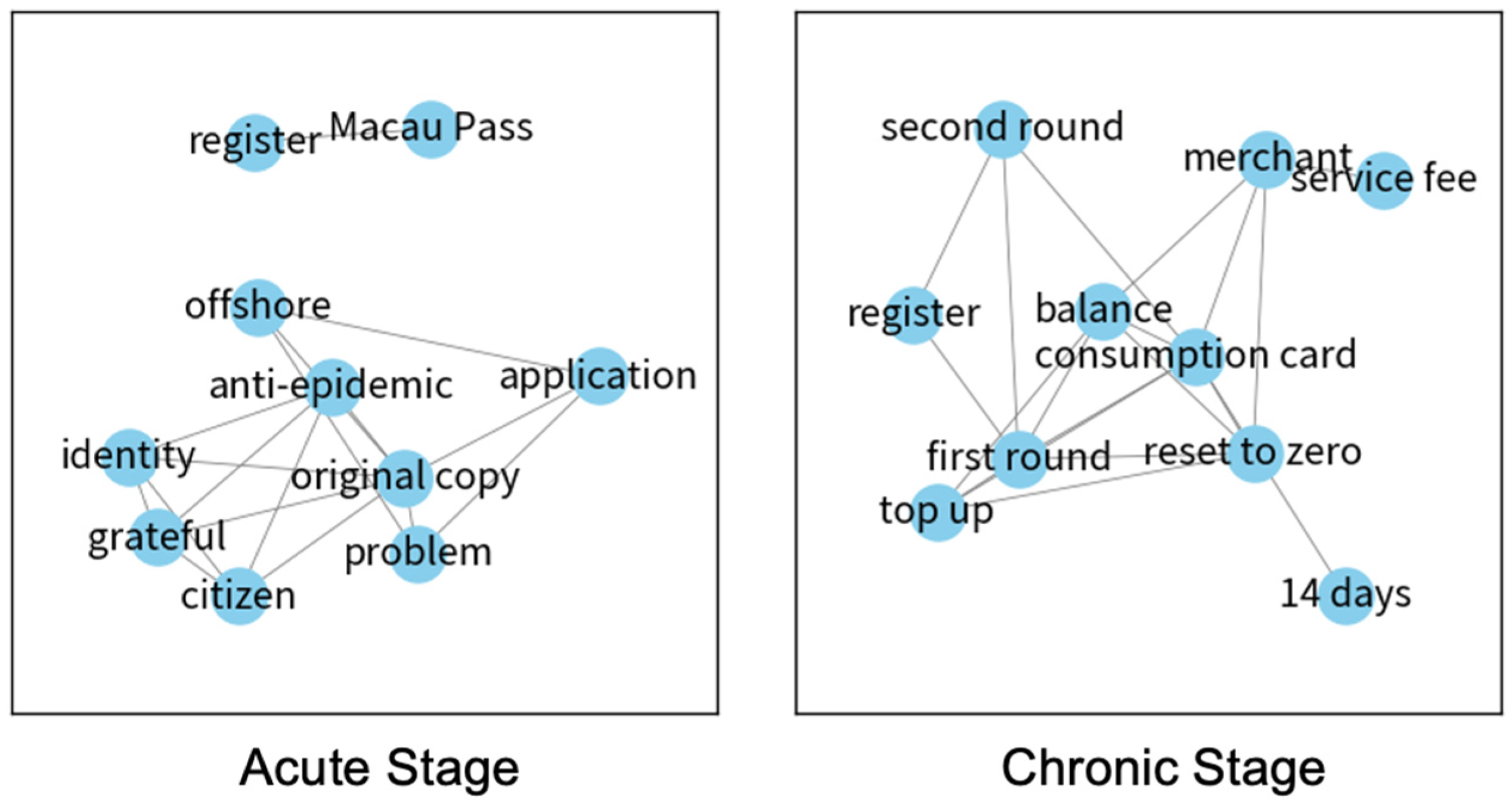Social Media Engagement in Two Governmental Schemes during the COVID-19 Pandemic in Macao
Abstract
:1. Introduction
2. Background
3. Methods
3.1. Defining Crisis Stages
3.2. Data Collection
3.3. Data Analysis
- (1)
- Positive emotions which included likes, love, and care emotions expressed along with the posts
- (2)
- Negative emotions which included angry and sad emotions
- (3)
- Numbers of comments which reflected the commitments and motivations of interactions and discussions
- (4)
- Numbers of shares, which reflected content recognition and reach.
4. Results
4.1. Content Analysis of Posts
4.2. Engagement Analysis of Posts
4.2.1. Engagement of the Face Mask Supply Scheme
4.2.2. Engagement of the Consumption Voucher Scheme
4.3. Word and Network Analysis of Comments
5. Discussion
6. Limitations
7. Conclusions
Author Contributions
Funding
Institutional Review Board Statement
Informed Consent Statement
Data Availability Statement
Conflicts of Interest
References
- Ahrestha, N.; Shad, M.Y.; Ulvi, O.; Khan, M.H.; Karamehic-Muratovic, A.; Nguyen, U.-S.D.T.; Baghbanzadeh, M.; Wardrup, R.; Aghamohammadi, N.; Cervantes, D.; et al. The impact of COVID-19 on globalization. One Health 2020, 11, 100180. [Google Scholar] [CrossRef]
- Thornton, J. Covid-19: Trust in government and other people linked with lower infection rate and higher vaccination uptake. BMJ 2022, 376, o292. [Google Scholar] [CrossRef] [PubMed]
- Tsao, S.-F.; Chen, H.; Tisseverasinghe, T.; Yang, Y.; Li, L.; Butt, Z.A. What social media told us in the time of COVID-19: A scoping review. Lancet Digit. Health 2021, 3, e175–e194. [Google Scholar] [CrossRef]
- Al-Dmour, H.; Masa’deh, R.; Salman, A.; Abuhashesh, M.; Al-Dmour, R. Influence of Social Media Platforms on Public Health Protection Against the COVID-19 Pandemic via the Mediating Effects of Public Health Awareness and Behavioral Changes: Integrated Model. J. Med. Internet Res. 2020, 22, e19996. [Google Scholar] [CrossRef] [PubMed]
- Ahmed, W.; Vidal-Alaball, J.; Lopez Segui, F.; Moreno-Sánchez, P.A. A Social Network Analysis of Tweets Related to Masks during the COVID-19 Pandemic. Int. J. Environ. Res. Public Health 2020, 17, 8235. [Google Scholar] [CrossRef]
- Ahmed, W.; Vidal-Alaball, J.; Vilaseca, J.M. A Social Network Analysis of Twitter Data Related to Blood Clots and Vaccines. Int. J. Environ. Res. Public Health 2022, 19, 4584. [Google Scholar] [CrossRef] [PubMed]
- Zhang, Z.; Feng, G.; Xu, J.; Zhang, Y.; Li, J.; Huang, J.; Akinwunmi, B.; Zhang, C.J.P.; Ming, W.-k. The Impact of Public Health Events on COVID-19 Vaccine Hesitancy on Chinese Social Media: National Infoveillance Study. JMIR Public Health Surveill. 2021, 7, e32936. [Google Scholar] [CrossRef]
- Tang, Z.; Miller, A.S.; Zhou, Z.; Warkentin, M. Does government social media promote users’ information security behavior towards COVID-19 scams? Cultivation effects and protective motivations. Gov. Inf. Q. 2021, 38, 101572. [Google Scholar] [CrossRef]
- Ahmed, W.; Vidal-Alaball, J.; Downing, J.; López Seguí, F. COVID-19 and the 5G Conspiracy Theory: Social Network Analysis of Twitter Data. J. Med. Internet Res. 2020, 22, e19458. [Google Scholar] [CrossRef]
- Shahsavari, S.; Holur, P.; Wang, T.; Tangherlini, T.R.; Roychowdhury, V. Conspiracy in the time of corona: Automatic detection of emerging COVID-19 conspiracy theories in social media and the news. J. Comput. Soc. Sci. 2020, 3, 279–317. [Google Scholar] [CrossRef]
- Mohammed Ali, B. Empowering Healthcare, Economic, and Social Resilience during Global Pandemic Covid-19. Int. J. Technol. 2020, 11, 291–319. [Google Scholar]
- McCartney, G.; Pinto, J.; Liu, M. City resilience and recovery from COVID-19: The case of Macao. Cities 2021, 112, 103130. [Google Scholar] [CrossRef]
- Mustapa, A.N.; Mohamad, A. Malaysian Government Business Support and Assistance for Small and Medium Enterprises: A Case of COVID-19 Pandemic Crisis. In Modeling Economic Growth in Contemporary Malaysia; Sergi, B.S., Jaaffar, A.R., Eds.; Emerald Publishing Limited: Bingley, UK, 2021; pp. 291–305. [Google Scholar]
- Fatouh, M.; Giansante, S.; Ongena, S. Economic support during the COVID crisis. Quantitative easing and lending support schemes in the UK. Econ. Lett. 2021, 209, 110138. [Google Scholar] [CrossRef]
- Păunescu, C.; Mátyus, E. Resilience measures to dealing with the COVID-19 pandemic Evidence from Romanian micro and small enterprises. Manag. Mark. 2020, 15, 439–457. [Google Scholar] [CrossRef]
- New Round of Face Mask Supply Scheme Starts Today. Available online: https://www.gov.mo/en/news/124521/ (accessed on 20 May 2022).
- Registration for Electronic Consumption Benefits Plan Starts on 10 May. Available online: https://www.gov.mo/en/news/267290 (accessed on 31 May 2022).
- Hsu, M.H.K. The Responses and Challenges of COVID-19 in Macao. In Proceedings of the 2020 The 4th International Conference on Education and Multimedia Technology, Online, 1 October 2020; pp. 226–229. [Google Scholar]
- Howard, J.; Huang, A.; Li, Z.; Tufekci, Z.; Zdimal, V.; van der Westhuizen, H.-M.; von Delft, A.; Price, A.; Fridman, L.; Tang, L.-H.; et al. An evidence review of face masks against COVID-19. Proc. Natl. Acad. Sci. USA 2021, 118, e2014564118. [Google Scholar] [CrossRef]
- The Face Mask Global Value Chain in the COVID-19 Outbreak: Evidence and Policy Lessons. Available online: https://www.oecd.org/coronavirus/policy-responses/the-face-mask-global-value-chain-in-the-COVID-19-outbreak-evidence-and-policy-lessons-a4df866d (accessed on 20 May 2022).
- Ieng, S.M.; Cheong, I.H. An Overview of Epidemiology of COVID-19 in Macau S.A.R. Front. Public Health 2020, 8, 550057. [Google Scholar] [CrossRef]
- Fink, S. Crisis Management: Planning for the Inevitable; American Management Association: New York, NY, USA, 1986. [Google Scholar]
- Pang, P.C.-I.; Cai, Q.; Jiang, W.; Chan, K.S. Engagement of Government Social Media on Facebook during the COVID-19 Pandemic in Macao. Int. J. Environ. Res. 2021, 18, 3508. [Google Scholar] [CrossRef]
- Macao Association for Internet Research. Internet Usage Trends in Macao 2020; Macao Association for Internet Research: Macau, China, 2020. [Google Scholar]
- Jha, A.; Lin, L.; Savoia, E. The Use of Social Media by State Health Departments in the US: Analyzing Health Communication through Facebook. J. Community Health 2016, 41, 174–179. [Google Scholar] [CrossRef]
- Haro-de-Rosario, A.; Sáez-Martín, A.; del Carmen Caba-Pérez, M. Using social media to enhance citizen engagement with local government: Twitter or Facebook? New Media Soc. 2016, 20, 29–49. [Google Scholar] [CrossRef]
- Tang, U.W.; Sheng, N. Macao. Cities 2009, 26, 220–231. [Google Scholar] [CrossRef]
- McCartney, G. The impact of the coronavirus outbreak on Macao. From tourism lockdown to tourism recovery. Curr. Issues Tour. 2021, 24, 2683–2692. [Google Scholar] [CrossRef]
- Liu, M.T.; Wang, S.; McCartney, G.; Wong, I.A. Taking a break is for accomplishing a longer journey: Hospitality industry in Macao under the COVID-19 pandemic. Int. J. Contemp. Hosp. Manag. 2021, 33, 1249–1275. [Google Scholar] [CrossRef]
- Loi, K.I.; Lei, W.S.; Lourenço, F. Understanding the reactions of government and gaming concessionaires on COVID-19 through the neo-institutional theory—The case of Macao. Int. J. Hosp. Manag. 2021, 94, 102755. [Google Scholar] [CrossRef]
- Lio, C.F.; Cheong, H.H.; Lei, C.I.; Lo, I.L.; Yao, L.; Lam, C.; Leong, I.H. Effectiveness of personal protective health behaviour against COVID-19. BMC Public Health 2021, 21, 827. [Google Scholar] [CrossRef] [PubMed]
- Monthly Gross Revenue from Games of Fortune. Available online: https://www.dicj.gov.mo/web/en/information/DadosEstat_mensal/2020/index.html (accessed on 21 May 2022).
- Ma, E.; Chi Lam, C.C.; Im, U.L. The Effects of Pandemic on a Tourism City and the Impacts of Government Policies in Macao. In Virus Outbreaks and Tourism Mobility; Kulshreshtha, S.K., Ed.; Emerald Publishing Limited: Bingley, UK, 2021; pp. 147–160. [Google Scholar]
- Kowalczyk-Anioł, J.; Grochowicz, M.; Pawlusiński, R. How a Tourism City Responds to COVID-19: A CEE Perspective (Kraków Case Study). Sustainability 2021, 13, 7914. [Google Scholar] [CrossRef]
- MacKay, M.; Cimino, A.; Yousefinaghani, S.; McWhirter, J.E.; Dara, R.; Papadopoulos, A. Canadian COVID-19 Crisis Communication on Twitter: Mixed Methods Research Examining Tweets from Government, Politicians, and Public Health for Crisis Communication Guiding Principles and Tweet Engagement. Int. J. Environ. Res. Public Health 2022, 19, 6954. [Google Scholar] [CrossRef]
- Pang, P.C.-I.; Liu, L. Why Do Consumers Review Doctors Online? Topic Modeling Analysis of Positive and Negative Reviews on an Online Health Community in China. In Proceedings of the 53rd Hawaii International Conference on System Sciences (HICSS 2020), Grand Wailea, HI, USA, 1–10 July 2020; pp. 705–714. [Google Scholar] [CrossRef] [Green Version]
- Asghar, M.Z.; Iqbal, A.; Seitamaa-Hakkarainen, P.; Barbera, E. Breaching Learners’ Social Distancing through Social Media during the COVID-19 Pandemic. Int. J. Environ. Res. Public Health 2021, 18, 11012. [Google Scholar] [CrossRef]
- Sjödin, H.; Wilder-Smith, A.; Osman, S.; Farooq, Z.; Rocklöv, J. Only strict quarantine measures can curb the coronavirus disease (COVID-19) outbreak in Italy, 2020. Euro Surveill. 2020, 25, 2000280. [Google Scholar] [CrossRef] [PubMed]
- Erlingsson, C.; Brysiewicz, P. A hands-on guide to doing content analysis. Afr. J. Emerg. Med. 2017, 7, 93–99. [Google Scholar] [CrossRef]
- Stsiampkouskaya, K.; Joinson, A.; Piwek, L.; Ahlbom, C.-P. Emotional responses to likes and comments regulate posting frequency and content change behaviour on social media: An experimental study and mediation model. Comput. Hum. Behav. 2021, 124, 106940. [Google Scholar] [CrossRef]
- Lim, S.; Berry, F.S.; Lee, K.H. Stakeholders in the same bed with different dreams: Semantic network analysis of issue interpretation in risk policy related to mad cow disease. J. Public Adm. Res. Theory 2016, 26, 79–93. [Google Scholar] [CrossRef]
- Luo, R.; Xu, J.; Zhang, Y.; Ren, X.; Sun, X. PKUSEG: A Toolkit for Multi-Domain Chinese Word Segmentation. arXiv 2019, arXiv:1906.11455. [Google Scholar]
- Bird, S.; Klein, E.; Loper, E. Natural Language Processing with Python; O’Reilly Media, Inc.: Sebastopol, CA, USA, 2009. [Google Scholar]
- Hagberg, A.; Schult, D.; Swart, P. Exploring network structure, dynamics, and function using NetworkX. In Proceedings of the 7th Python in Science Conference (SciPy2008), Pasadena, CA, USA; 21 August 2008; pp. 11–15. [Google Scholar]
- Pang, P.C.-I.; McKay, D.; Chang, S.; Chen, Q.; Zhang, X.; Cui, L. Privacy concerns of the Australian My Health Record: Implications for other large-scale opt-out personal health records. Inf. Process. Manag. 2020, 57, 102364. [Google Scholar] [CrossRef]
- Dai, J. On the Regulation of Social Psychology in the Public Crisis Management. J. South China Norm. Univ. 2006, 3, 117–122. [Google Scholar]
- Plough, A.; Fielding, J.E.; Chandra, A.; Williams, M.; Eisenman, D.; Wells, K.B.; Law, G.Y.; Fogleman, S.; Magaña, A. Building community disaster resilience: Perspectives from a large urban county department of public health. Am. J. Public Health 2013, 103, 1190–1197. [Google Scholar] [CrossRef]
- Chen, J.; Zhang, R.; Han, R. Macao’s achievements in the construction of social security system. J. Nanjing Univ. Posts Telecommun. 2019, 21, 11–20. [Google Scholar] [CrossRef]
- Cuervo, I.; Leopold, L.; Baron, S. Promoting Community Preparedness and Resilience: A Latino Immigrant Community–Driven Project Following Hurricane Sandy. Am. J. Public Health 2017, 107, S161–S164. [Google Scholar] [CrossRef]
- Coronavirus Rumor Control. Available online: https://www.fema.gov/disaster/coronavirus/rumor-control (accessed on 1 May 2022).
- Sun, L.; Pang, P.C.-I.; Si, Y.W. Roles of information propagation of Chinese microblogging users in epidemics: A crisis management perspective. Internet Res. 2020, 31, 540–561. [Google Scholar] [CrossRef]




| Crisis Stage | Definition | Start Time | End Time |
|---|---|---|---|
| Prodromal | This comes before the actual crisis, and its focus is to prevent or delay the crisis from happening. | The start of the current analysis | The first confirmed COVID-19 case |
| Acute | After the prodromal stage, the acute stage is signaled by the sudden onset of the event, and the event often develops rapidly. The main goals lie in controlling the crisis and avoiding its deterioration. | The first confirmed case | 28 days after the last case of local transmissions |
| Chronic | The crisis situation begins to ease in this stage and its appearance is less dramatic in appearance. As such, the focus should be on relieving controlling measures, reducing damage, and initiating the steps towards recovery. | The first day after the acute period | The end of the current analysis |
| Resolution | The crisis is over at this stage. Learnings should be synthesized for preparing the responses to future crises and the society/organization is returning to normal. | Not applicable (since the world is still in the middle of the pandemic at the time of writing, this stage is not applicable). | |
| Theme | Sample Quotation |
|---|---|
| Supporting small and medium enterprises | “It is hoped to attract consumers to small and medium-sized enterprises by issuing electronic consumer vouchers with targeted functions to maintain consumption momentum and expand domestic demand … and support the development of small and medium-sized enterprises and merchants” |
| Supporting families and citizens with difficulties | “This measure alleviated the pressure of workers due to temporary loss of income or income reduction and could be considered as people-friendly” |
| Securing face mask supply | “Due to the very high demand for masks and limited global supply, the Health Bureau was looking for the supply of masks in different places worldwide… They promised that masks would be supplied immediately once they were available” |
| Fine-tuning government measures | “To deal with infectious diseases, continuous optimization (of the measures) was needed. Because infectious diseases were unpredictable and uncertain, measures had to be continuously optimized and adjusted. When the epidemic eases, some measures would be changed or withdrawn” |
| Providing face masks to students and minority | “The measures introduced by the Higher Education Bureau to assist Macao students studying abroad to purchase masks largely alleviated the shortage of protective gear for Macao students studying abroad. The government provided affirmation and support to them in such a time” |
| Appreciation from different groups of citizens | “More than 95% of the interviewed citizens agreed that the government’s face mask supply program could prevent the spread of the epidemic, reduce the panic of buying masks and play a key role in the fight against the epidemic” |
| Rank | Prodromal Stage | Acute Stage | Chronic Stage |
|---|---|---|---|
| 1 | pharmacy (N = 26, ec = 0.360) | grateful (N = 192, ec = 0.485) | kids (N = 19, ec = 0.491) |
| 2 | sold out (N = 26, ec = 0.047) | cheer up (N = 130, ec = 0.416) | start of the school year (N = 15, ec = 0.313) |
| 3 | citizen (N = 13, ec = 0.358) | you (N = 107, ec = 0.486) | go to school (N = 13, ec = 0.218) |
| 4 | line up (N = 11, ec = 0.025) | everyone (N = 65, ec = 0.223) | friendly (N = 7, ec = 0.137) |
| 5 | convenient (N = 9, ec = 0.077) | hard work (N = 53, ec = 0.283) | problem (N = 6, ec = 0.176) |
| 6 | supply (N = 7, ec = 0.115) | frontline staff (N = 48, ec = 0.205) | safe (N = 6, ec = 0.081) |
| 7 | flow of people (N = 7, ec = 0.028) | thank you (N = 48, ec = 0.140) | citizen (N = 6, ec = 0.063) |
| 8 | quality (N = 6, ec = 0.070) | stay safe (N = 45, ec = 0.169) | tourist (N = 6, ec = 0.049) |
| 9 | ID card (N = 5, ec = 0.156) | hope (N = 27, ec = 0.099) | school (N = 5, ec = 0.181) |
| 10 | web page (N = 5, ec = 0.084) | salute (N = 24, ec = 0.062) | September (N = 5, ec = 0.163) |
| Rank | Prodromal Stage | Acute Stage | Chronic Stage |
|---|---|---|---|
| 1 | No words in this stage because the scheme was announced after this stage. | register (N = 5, ec = 0.033) | consumption card (N = 7, ec = 0.332) |
| 2 | citizen (N = 4, ec = 0.391) | top up (N = 6, ec = 0.045) | |
| 3 | original copy (N = 3, ec = 0.234) | first round (N = 5, ec = 0.053) | |
| 4 | problem (N = 3, ec = 0.028) | register (N = 5, ec = 0.020) | |
| 5 | application (N = 3, ec = 0.018) | 14 days (N = 2, ec = 0.238) | |
| 6 | Macau Pass (N = 3, ec = 0.017) | balance (N = 2, ec = 0.114) | |
| 7 | offshore (N = 3, ec = 0.017) | reset to zero (N = 2, ec = 0.114) | |
| 8 | anti-epidemic (N = 2, ec = 0.382) | merchant (N = 2, ec = 0.107) | |
| 9 | grateful (N = 2, ec = 0.382) | second round (N = 2, ec = 0.034) |
Publisher’s Note: MDPI stays neutral with regard to jurisdictional claims in published maps and institutional affiliations. |
© 2022 by the authors. Licensee MDPI, Basel, Switzerland. This article is an open access article distributed under the terms and conditions of the Creative Commons Attribution (CC BY) license (https://creativecommons.org/licenses/by/4.0/).
Share and Cite
Pang, P.C.-I.; Jiang, W.; Pu, G.; Chan, K.-S.; Lau, Y. Social Media Engagement in Two Governmental Schemes during the COVID-19 Pandemic in Macao. Int. J. Environ. Res. Public Health 2022, 19, 8976. https://doi.org/10.3390/ijerph19158976
Pang PC-I, Jiang W, Pu G, Chan K-S, Lau Y. Social Media Engagement in Two Governmental Schemes during the COVID-19 Pandemic in Macao. International Journal of Environmental Research and Public Health. 2022; 19(15):8976. https://doi.org/10.3390/ijerph19158976
Chicago/Turabian StylePang, Patrick Cheong-Iao, Wenjing Jiang, Guanwen Pu, Kin-Sun Chan, and Ying Lau. 2022. "Social Media Engagement in Two Governmental Schemes during the COVID-19 Pandemic in Macao" International Journal of Environmental Research and Public Health 19, no. 15: 8976. https://doi.org/10.3390/ijerph19158976
APA StylePang, P. C.-I., Jiang, W., Pu, G., Chan, K.-S., & Lau, Y. (2022). Social Media Engagement in Two Governmental Schemes during the COVID-19 Pandemic in Macao. International Journal of Environmental Research and Public Health, 19(15), 8976. https://doi.org/10.3390/ijerph19158976







